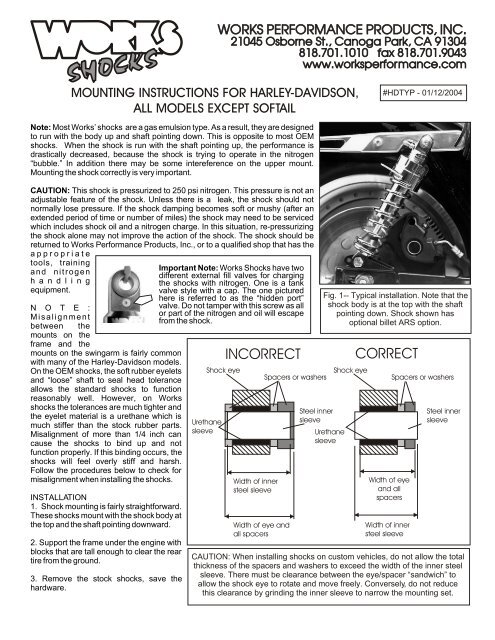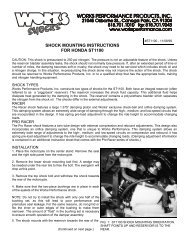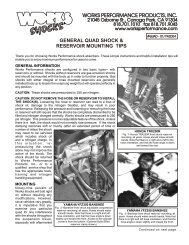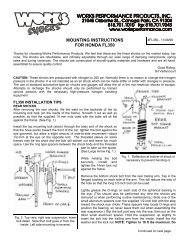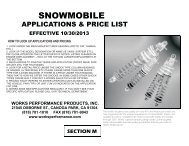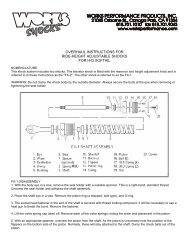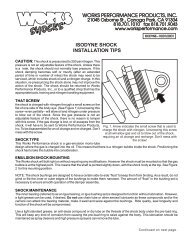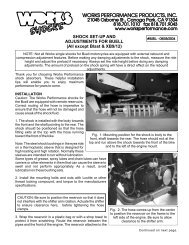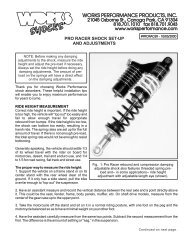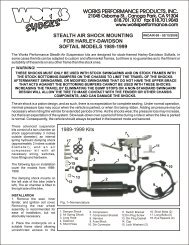Models Except Softail) Mounting Instructions - Works Shocks
Models Except Softail) Mounting Instructions - Works Shocks
Models Except Softail) Mounting Instructions - Works Shocks
Create successful ePaper yourself
Turn your PDF publications into a flip-book with our unique Google optimized e-Paper software.
Harley <strong>Instructions</strong> continued Page 2CHANNEL STYLE SWINGARMSOVERHUNG OR SIDE MOUNTSWINGARMSILLUSTRATION INDICATING USE OFWASHERS OR SPACER PLACEMENTTO CURE MISALIGNMENT.ILLUSTRATION INDICATING USE OFWASHERS OR SPACER PLACEMENTTO CURE MISALIGNMENT.4. Install the <strong>Works</strong> shocks in the top mount on both sides. Tighten thefasteners.5. Allow the shock to seek a relaxed position above the shock mounts.Check to see how close or how far away the eye is from the channel orflange. Ideally the shock should naturally drop into the correct position. Ifyou have to pull or push the shock over to make it line up with the mounts,then the shocks will be in a bind and not function correctly.6. If the shocks are not lined up, addwashers if necessary to space themappropriately. On some of the shockswith side spacers (aluminum washersthat fit over the bushing) they can beswapped to improve the offset. It ispossible that changing the sidespacers on the body end (if soequipped) can help with thealignment. Take some time with thisbecause it will pay off in ride comfort.SHOCK EYE SPACINGTO PREVENT BINDING.APPLIES TO EACHEND OF SHOCK.FLANGEBUSHINGSTEELWASHEROFFSET EYE SPACERAND FLANGE BUSHINGPOSTIONS ON MOST BELTDRIVE MODELSFRAMEOFFSET EYE ISUSED TO PROVIDECLEARANCE. THESHAFT ASSEMBLYCAN BE ROTATED180 IF NECESSARY.NOTE: The shock bushings aredesigned to have a certain side-toside“float” to keep them from binding.As a result, do not grind or file the inneror outer edges of the bushings tomake them narrower. The amount of"float" in the bushing set is necessaryto ensure smooth operation of the.020".020"MINIMUM .020"CLEARANCE ONEACH SIDE OFSHOCK EYE.OFFSET EYESWINGARMMOUNTSIDE SPACER ON BUSHINGMOUNTS TO SWINGARM SIDE.
Harley <strong>Instructions</strong> continued Page 3damper assembly. If the shock eyes are tightened metal-to-metal(the outer faces of the eyes to the flanges or washers), this will leadto a harsh, stiff or choppy ride and premature seal leakage.7. Once you are satisfied with the alignment, sparingly apply athread locking compound to the threads on the shock mountingfasteners and tighten them to the appropriate torque. Overtighteningthe fasteners can damage the bushings and cause theshock to bind. This results in harsh, choppy performance andpremature seal failure.MULTI-RATE SPRINGS AND THE ARS SYSTEMDepending on each application, single or dual-rate springs areavailable. Dual-rate springs are just that-- a spring set with twoseparate rates. This is done with a short spring stacked on a longerspring. As both springs collapse they produce a soft, or initial, rate.The spring set will maintain this initial rate until the short springstops compressing. At that point, the spring rate "crosses over" tothe stiffer, or final, rate. This multi-rate system allows a soft initialrate for comfort on small bumps, but has the capability of soakingup the big pot-holes and other road hazards.ARS stands for Adjustable Rate Suspension. ARS is standard onsome dual-rate spring shocks. The ARS system allows the rider toincrease or decrease the load-carrying capacity of the shockswithout changing the pre-load of the springs. Depending on theapplication and spring set, the rider can increase the load capacityof the shocks up to 50 percent. This allows the shocks to be correctfor solo riding, but still handle the increased weight of a passengerand/or baggage. ARS can also be employed during solo riding tostiffen the rates for aggressive riding, or for riding on rough, brokenpavement.Fig. 2-- Shock compressed with the ARS lever in thesoftest position. The deepest slot allows the spring setto stay softer longer. The shallowest slot allows thespring set to get stiffer sooner.The ARS system consists of an indexing lever and a stepped cup that contains the short spring of the dual-rate. The position ofthe lever in relation to the steps in the cup determines how long the spring set remains on the soft, or initial, spring rate. On mostARS applications, four positions can be selected from full stiff to full soft. Indexing is done in a matter of seconds by rotating thelever or the cup by hand. Indexing the cup to the lever is usually preferable to avoid interference with passenger or bags.Adjustment of the ARS system should only be made while the motorcycle is unloaded to reduce the load on the springs.NOTE: It is important to make sure that a step in the cup is positioned directly over the tang on the lever. This will preventdamage to the cup and/or lever that can be caused by making partial contact between the tang and a step.TUNING TIPS—The “softest” setting on the ARS does not mean that the ride will be the most comfortable at that setting. Itmeans that this is the softest spring setting which would be employed on smooth roads and with a solo rider. Excessivesuspension bottoming caused by rough roads or by the addition of a passenger or bags will cause a harsh ride when the shockis adjusted to this setting. To eliminate this bottoming, adjust the ARS to the stiffer positions for a more comfortable ride. Hence,sometimes “stiffer is softer.”PRE-LOAD ADJUSTMENT—On some <strong>Works</strong> shocks a threaded pre-load is standard. This allows the adjustment of the rideheight of the motorcycle. The pre-load is changed by turning a threaded nut down towards the spring (higher ride height) or upaway from the spring (lower ride height). The nut is a right-hand thread. It is used primarily to set the ride height for solo riding,as the ARS would be employed when adding a passenger or extra weight.CHECKING RIDE HEIGHT—1. With the bike unloaded on the side stand and the shock fully extended, have an assistant measure from a point at the axle(center point) to a point on the frame, fender or bodywork directly above it. Record this measurement.2.With the bike off the stand and the rider in the seat, bounce on the suspension and let the bike settle. Have the assistantmeasure from the same two points. Subtract the second measurement from the first.3. For models equipped with the stock length shock, the difference should be between 1 inch (minimum) and 1-1/2 inches(maximum). (Short shocks can range from 1/2 inch to 3/4 inch.) the amount of settle, or “sag” is a function of the wheel travel. Itshould only be between 1/4 and 1/3 of the total travel.
Harley <strong>Instructions</strong> continued Page 44. If the difference is less than the minimum, reduce the spring pre-load. Measure the distance again starting with Step 2.Adjust again if necessary.5. If the difference is more than the maximum, increase the spring pre-load. Measure the distance again starting with Step 2.Adjust again if necessary.Note: If the ride height is too low, the shock will bottom unnecessarily, resulting in a harsh ride. If the ride height is too high, theshock will “top out” too easily when rebounding from a bump or under hard deceleration.NITROGEN PRESSURESCAUTION: The pressure in these shocks cannot successfully be checked. Concerns with the gauge volume and the gasvolume in the shock body create a situation where you cannot accurately determine what pressure was in the shock. In additionwhen the pressure is lowered (i.e. checking the pressure) the gas and some of the shock oil escapes into the gauge. It ispossible to lose a large percentage of the shock oil by depressing the core of a charged shock to the atmosphere.Please note that in order to check the pressure, some of the gas must escape and fill the gauge assembly. The volume of thegas pocket is about half the size of your thumb, so a very small volume change results in a large pressure drop. Because thegauges' volumes vary, it is not possible to deduce the actual pressure in the shock prior to attaching the gauge. Therefore it isimperative that any attempt to check pressure be accompanied by the capability of refilling the shock. In other words: If youdon't have a nitrogen source handy, don't check the pressure!PRESSURIZING THE SHOCK AFTER SERVICEThe pressure setting for emulsion gas shocks is 250 p.s.i. To pressurize a shock with some residual pressure in it, bring thegauge manifold up to 250 p.s.i. and depress the core with the T-handle. This will either equalize the pressure or refill the shockwithout transferring oil from the shock into the gauge assembly.The best gauges for this purpose screw on to the valve and incorporate a T-handled core depressor to isolate the shock fromthe gauge. This allows a leak-free separation once the desired pressure is reached. For simplified operation, an extra valve isprovided for the filling apparatus, allowing pressure adjustment with the gauge in place. <strong>Works</strong> offers a suitable manifold withattachment, fill valve and gauge. Most motorcycle shops that deal with dirt bikes can pressurize the shock.SERVICE PARTSOverhaul seal kit — #SL-S-KIT2Overhaul seal kit w/ piston ring — #SL-S-KIT2CPre-load wrench — #PL-S-SPANNERSeal holder wrench — #SLH-S-SPANNERDUAL-RATE FORK SPRINGS<strong>Works</strong> Performance adjustable dual-ratefork springs provide a soft initial rate forsmall bumps and pavement seams, butthen “cross over” to a higher rate forpotholes and other bad pavement.Unlike progressively wound springswhich have the progression preset intothe springs, these dual-rate sets allowthe rider to choose the point at which thesprings go from the soft initial rate to thestiffer final rate. This accommodatesvarious rider weights, riding styles, roador track conditions and personal preference. One set of springs for one fork tube consists of a long spring, a short spring, preloadspacer material (in most cases), separating washers and three different pairs of metal spacers that determine the "crossover"point of the spring set. The shortest length causes the spring set to cross over later, so the forks remain softer longer. Thelongest length causes the spring set to cross over sooner resulting in the stiffer overall rate. The medium-length spacerprovides the best average for most suspensions.


